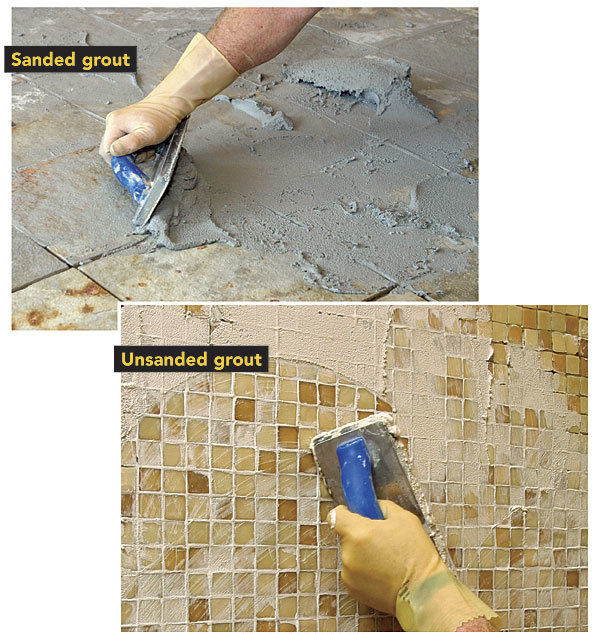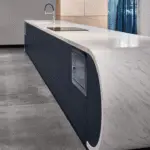Are you standing in the hardware store aisle, staring at rows of caulk, wondering whether to choose sanded or unsanded? You’re not alone.
Making the right choice between sanded and unsanded caulk can be the difference between a polished finish and a disappointing result. Your home projects deserve the best, and understanding the subtle differences can save you time, money, and frustration. Dive into this guide to discover which type of caulk is perfect for your needs.
With insights that cut through the confusion, you’ll feel confident in your decision and ready to tackle your next project with ease. Keep reading to unlock the secrets behind these two essential home improvement tools.

Credit: www.cravingsomecreativity.com
Sanded Caulk Basics
Choosing the right caulk can make or break your home improvement project. Sanded caulk is one option that you might consider, especially if your project involves tiling or needing a strong bond. Understanding the basics of sanded caulk is essential to determine if it fits your needs.
Composition And Characteristics
Sanded caulk is made by mixing fine sand with latex or silicone. This gritty texture provides extra strength and durability. The sand particles enhance the caulk’s grip, making it less prone to cracking or shrinking.
The presence of sand also gives sanded caulk a slightly rough finish, which can match certain textured surfaces. It’s often more rigid compared to unsanded variants, providing a sturdy bond.
Have you ever tried smoothing sanded caulk into a tile seam? The texture might surprise you, but it ensures a firm hold that lasts longer.
Common Uses And Applications
Sanded caulk is ideal for tiling projects, particularly for areas like bathrooms and kitchens. It complements grout lines, offering a seamless appearance when used between tiles.
If you’re working on a countertop or backsplash, sanded caulk can help reinforce the joints. Its durability makes it perfect for high-traffic areas that require robust sealing.
Imagine finishing your tiling work and noticing how well the sanded caulk blends with the grout, giving your space a polished look. This caulk is not just functional; it adds aesthetic value.
Think about your next project. Could sanded caulk be the missing piece for a flawless finish? Let its strength and texture work to your advantage.
Unsanded Caulk Basics
Unsanded caulk is a popular choice for sealing gaps and joints. Its smooth texture makes it ideal for delicate applications. This type of caulk offers a seamless finish and is easy to apply. In this section, learn about its composition, characteristics, and uses.
Composition And Characteristics
Unsanded caulk is free from gritty particles. It has a smooth and creamy consistency. This allows for precise application in tight spaces. It is often made with latex or silicone. Both materials provide flexibility and durability. Unsanded caulk can stretch without cracking. It maintains a neat appearance over time.
Common Uses And Applications
Unsanded caulk is perfect for indoor projects. It seals bathroom tiles and kitchen countertops. Use it around sinks and bathtubs for a watertight seal. It works well on tiles, glass, and ceramic. Unsanded caulk is often used in crafts and DIY tasks. It is easy to clean and paint over. This makes it versatile for home improvements.
Performance Comparison
Choosing between sanded and unsanded caulk affects durability and finish. Sanded caulk offers better crack resistance, ideal for wider joints. Unsanded caulk provides a smoother appearance, perfect for delicate surfaces and tight spaces.
When deciding between sanded and unsanded caulk, understanding their performance differences can guide your choice. Knowing how each type performs in terms of durability, flexibility, adhesion, and coverage can save you time and money in the long run. Let’s break down these aspects to see which type of caulk might suit your needs best.Durability And Flexibility
Durability is key in any caulking job. Sanded caulk tends to be more durable in larger gaps, often found in tile work. It holds up well against wear and tear, making it ideal for areas with heavy foot traffic. However, if you need caulk that adjusts to movement, unsanded caulk offers superior flexibility. This makes it perfect for areas prone to expansion and contraction, like around windows and doors. Flexibility can be a game-changer. When I was sealing my bathroom tiles, the unsanded caulk adjusted perfectly to the slight shifts in the structure over time. Have you considered how much flexibility you need for your project?Adhesion And Coverage
Adhesion is crucial for a long-lasting seal. Unsanded caulk generally offers better adhesion, especially on smooth surfaces like ceramic tiles or glass. It creates a strong bond that stands the test of time. Sanded caulk, however, might struggle with adhesion on these smoother surfaces due to its gritty texture. Coverage is another aspect where these two caulks differ. Sanded caulk is thicker and can cover larger gaps more effectively, which can be a time-saver if you’re working on a big project. Unsanded caulk is thinner, which might require more layers but offers a neater finish. Consider the scale of your project and the surface type to determine the best coverage for your needs. Have you ever started a project and realized halfway through that you chose the wrong material? Understanding these differences can help you avoid that frustration. What do you think is more important for your project—adhesion or coverage?Aesthetic Considerations
Choosing between sanded and unsanded caulk can affect your project’s look. Each type offers unique aesthetic qualities. Understanding these can help you make the right choice. Consider the texture, appearance, and color matching. These factors play a crucial role in the final outcome.
Texture And Appearance
Sanded caulk has a gritty texture. This is due to added sand particles. It works well with rough surfaces. Think about tiled floors or textured walls. The roughness helps it blend in. Unsanded caulk has a smooth finish. This makes it ideal for sleek, polished surfaces. Perfect for glass tiles or shiny ceramics. The smoothness gives a clean, neat look.
Color Matching
Color can make or break a project. Sanded caulk often comes in fewer colors. This may limit your choices. It usually matches earthy or neutral tones. Unsanded caulk offers a wider color range. This makes it easier to find an exact match. You can choose from whites, pastels, and even bold shades. Matching caulk color to your surface enhances harmony.
Cost Analysis
When choosing between sanded and unsanded caulk, cost is key. It’s important to understand the financial impact of each option. This analysis covers both material and installation costs, offering a clear picture of expenses involved.
Material Costs
Sanded caulk often costs more due to its composition. It includes extra materials like sand, which increases the price. This type is ideal for filling larger gaps and joints. Unsanded caulk is usually cheaper. It lacks the extra materials found in sanded caulk. This makes it a budget-friendly choice for smaller gaps.
Installation Costs
Installation costs vary based on the complexity of the job. Sanded caulk can be more labor-intensive. It may require more time to apply and smooth out. This can lead to higher labor costs. Unsanded caulk is often easier to apply. It requires less time, reducing labor expenses. Choosing the right type impacts total costs significantly.

Credit: www.finehomebuilding.com
Project Suitability
Choosing the right caulk is crucial for any project. Sanded and unsanded caulk serve different purposes. Understanding project suitability helps in making informed decisions. It ensures the caulk’s effectiveness and longevity.
Indoor Applications
Sanded caulk is ideal for indoor areas where durability matters. It withstands high traffic and frequent cleaning. Bathrooms and kitchens often benefit from sanded caulk. Its texture provides better grip in tile joints. Unsanded caulk is smoother, perfect for delicate surfaces. It suits areas like drywall and woodwork. It prevents damage to fragile materials.
Outdoor Applications
Outdoor projects demand caulk that can resist weather elements. Sanded caulk is robust, suitable for exterior surfaces. It handles temperature changes well. Unsanded caulk works on smooth exterior walls. It seals gaps without affecting aesthetics. Consider factors like exposure and material type. Both types offer unique benefits for outdoor use.
Maintenance And Longevity
Sanded caulk offers better durability and is less prone to cracking, making it ideal for high-traffic areas. Unsanded caulk provides a smoother finish, perfect for delicate surfaces requiring subtle touch and flexibility. Both types require regular maintenance to ensure longevity and effectiveness in sealing gaps and preventing damage.
When choosing between sanded and unsanded caulk, understanding their maintenance and longevity is key to ensuring your project stands the test of time. Both types have distinct characteristics that affect how often you’ll need to clean and maintain them, as well as when reapplication might be necessary. Let’s dive into how each type fares in terms of upkeep and durability.Cleaning And Care
Keeping caulk clean can extend its life significantly. Sanded caulk, with its gritty texture, tends to attract more dirt and grime, making it a bit more challenging to clean. A mild detergent and a soft brush are often needed to scrub away residue without damaging the surface. On the other hand, unsanded caulk is smoother and less porous, which often makes it easier to wipe down. A damp cloth might be all you need to keep it looking fresh. However, its smooth surface can sometimes highlight dirt more prominently, encouraging more frequent cleaning. How do you keep your caulk clean? Finding a routine that works for your type of caulk can save you time and energy in the long run.Reapplication Needs
Regular inspections can help you spot when caulk needs replacing. Sanded caulk, due to its coarser nature, might crack or wear down faster in high-traffic areas. You might find yourself needing to reapply it more frequently, especially in places with a lot of movement or moisture. Unsanded caulk generally offers a longer lifespan, thanks to its flexibility and strength. It’s less prone to cracking and can hold up better in areas with less movement. But don’t be fooled; even the toughest caulk will eventually need a refresh to maintain its seal. When was the last time you checked your caulk? A simple touch can reveal if it’s time for a redo. Regular reapplication ensures your spaces stay sealed and protected. In summary, the choice between sanded and unsanded caulk impacts more than just the initial application. It affects how you clean and maintain your surfaces, and how often you’ll need to revisit your handiwork. Which type suits your lifestyle? A little attention now can save you from bigger fixes later.
Credit: www.tiktok.com
Choosing The Right Caulk
Choosing the right caulk depends on the surface and type of finish desired. Sanded caulk is ideal for larger gaps and textured surfaces, while unsanded caulk provides a smooth finish perfect for smaller joints and finer detailing. Selecting the appropriate caulk ensures durability and a polished appearance in any project.
Choosing the right caulk for your project can feel like a daunting task, especially when faced with options like sanded and unsanded varieties. It’s crucial to make an informed decision to ensure the durability and finish of your work. Your choice can significantly impact the final look and functionality of your project, whether you’re renovating a bathroom, sealing kitchen tiles, or enhancing any other space in your home.Evaluating Project Needs
First, assess the specific requirements of your project. Are you working on a high-moisture area like a bathroom, or a space that demands aesthetic finesse, such as a living room? The texture and type of caulk you choose should align with these conditions. For instance, sanded caulk is ideal for large gaps and areas where you want a textured finish. It’s perfect for matching grout lines in tile work. On the other hand, unsanded caulk is better suited for smaller joints and smoother surfaces, providing a sleek, polished appearance. Think about the material you’re working with. Are you dealing with glass tiles or natural stone? Each material may react differently to sanded or unsanded caulk, affecting adherence and longevity.Expert Recommendations
Consulting with professionals can offer valuable insights. Many experts suggest using unsanded caulk for glass tiles to avoid scratching the surface. This choice enhances the clarity and beauty of the glass. In contrast, sanded caulk is often recommended for ceramic tiles with wider joints. It provides a consistent look and prevents cracking. I once worked on a kitchen backsplash and found that sanded caulk gave a seamless finish between the tiles and the counter, handling the gap beautifully. What do experts say about color matching? They often recommend choosing a caulk that matches or complements your grout color to ensure a cohesive look. It’s worth spending extra time in the store, comparing swatches, to find the perfect shade. Have you considered the ease of application? Many professionals favor unsanded caulk for its smoother application, making it easier for DIYers. Yet, sanded caulk can offer a more professional-grade finish when handled correctly. Are you still wondering which caulk to choose? Reflect on your project’s specific needs, consult expert advice, and consider your personal experience. Making a well-informed decision will help you achieve a professional result that stands the test of time.Frequently Asked Questions
What Is The Difference Between Sanded And Unsanded Caulk?
Sanded caulk has added sand for texture. Unsanded caulk is smooth. Choose based on your surface needs.
Which Is Better For Bathroom Tiles, Sanded Or Unsanded Caulk?
Unsanded caulk is better for bathroom tiles. It is waterproof and prevents mold growth.
Can I Use Sanded Caulk On Smooth Surfaces?
Avoid sanded caulk on smooth surfaces. It might scratch or damage. Use unsanded for a neat finish.
Is Sanded Caulk Suitable For Outdoor Use?
Yes, sanded caulk is durable for outdoor use. It withstands weather and movement.
Does Unsanded Caulk Shrink Over Time?
Unsanded caulk might shrink a bit. Ensure proper application for minimal shrinkage.
Conclusion
Choosing between sanded and unsanded caulk depends on your specific needs. Sanded caulk offers strength and durability for wide joints. It’s ideal for tile and stone surfaces. Unsanded caulk provides a smooth finish for small gaps. It works well for delicate areas like glass and ceramics.
Both types have their unique benefits. Consider the surface and joint size before deciding. Proper application ensures long-lasting results. Remember, the right caulk enhances your project’s appearance and functionality. Make an informed choice to achieve the best outcome. Your project deserves the best finish possible.




